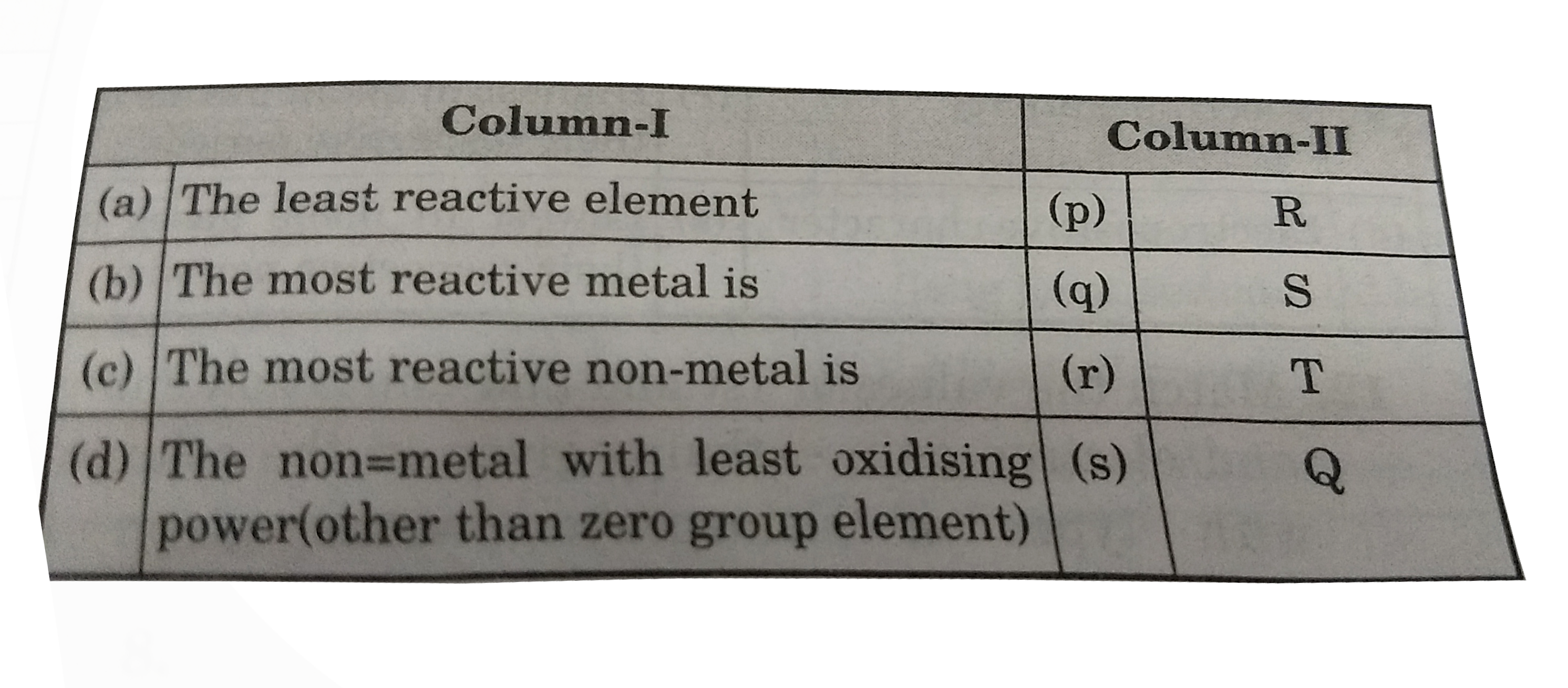The first and second ionisation enthalpy and the electron-gain enthalpy (in o a few elements are given below:

which of the above elements is likely to be:
(1) the least reactive element.
(2) the most reactive metal.
(3) The most reactive non-metal.
(1) Element V is least reactive metal as it has highest first, ionisation enthalpy & positive electron-gain enthalpy.
(2) Element II is the most reactive metal as it has lowest first ionisation enthalpy & low negative electron gain enthalpy.
(3) Element III is the most reactive non-metal because it has very high first ionisation enthalpy and very high negative electron gain enthalpy.
Topper's Solved these Questions
- CLASSIFICATION OF ELEMENTS & PERIODICITY IN PROPERTIESBOOK - CHHAYA PUBLICATIONCHAPTER - CLASSIFICATION OF ELEMENTS & PERIODICITY IN PROPERTIESEXERCISE - HIGHER ORDER THINKING SKILLS (HOTS) QUESTIONS
17 Videos
- CLASSIFICATION OF ELEMENTS & PERIODICITY IN PROPERTIESBOOK - CHHAYA PUBLICATIONCHAPTER - CLASSIFICATION OF ELEMENTS & PERIODICITY IN PROPERTIESEXERCISE - ENTRANCE QUESTION BANK
36 Videos
- CLASSIFICATION OF ELEMENTS & PERIODICITY IN PROPERTIESBOOK - CHHAYA PUBLICATIONCHAPTER - CLASSIFICATION OF ELEMENTS & PERIODICITY IN PROPERTIESEXERCISE - SOLVED WBCHSE SCANNER
35 Videos
- CHEMICAL BONDING AND MOLECULAR STRUCTUREBOOK - CHHAYA PUBLICATIONCHAPTER - CHEMICAL BONDING AND MOLECULAR STRUCTUREEXERCISE - PRACTICE SET
10 Videos
- REDOX REACTIONS BOOK - CHHAYA PUBLICATIONCHAPTER - REDOX REACTIONS EXERCISE - PRACTICE SET
4 Videos
Similar Questions
The first (Δi,H1) and the second (Δ,H2) ionisation enthalpies (in kJ mol−1 ) and the (ΔegH) electron gain enthalpy (in kJ mol−1 ) of a few elements are given below :

Which of the above elements is likely to be :
the least reactive element?
View SolutionThe first (Δi,H1) and the second (Δ,H2) ionisation enthalpies (in kJ mol−1 ) and the (ΔegH) electron gain enthalpy (in kJ mol−1 ) of a few elements are given below :

Which of the above elements is likely to be :
a reactive metal
View Solution
Knowledge Check
The first (ΔIH1) and second (ΔIH2) ionisation enthalpies (in kJ mol−1) and the (ΔegH) electron gain enthalpy (in kJ mol−1) of a few elements are given below:

The least reactive element is :APBQCRDTThe first (ΔiH1) and second (ΔiH2) ionization enthalpies (in kJ mol−1) and the electron gain enthalpy (ΔegH)(in kJ mol−1) of the elements I, II, III, IV and V are given below

the least reactive non - metal and the most reactive metal of these are respectivelyAIV and VBII and VCV and IIIDV and II
The first (ΔH1) and second (ΔH2) ionisation enthalpies (in kJmol−1) and the (ΔHeg) electron gain enthalpy (in kJmol−1) of a elements are given below:

Based on the above information match the following columns.

View SolutionThe first (ΔH1) and second (ΔH2) ionisation enthalpies (in kJmol−1) and the (ΔHeg) electron gain enthalpy (in kJmol−1) of a elements are given below:

Based on the above information match the following columns.

View SolutionThe first (IE1) and the second (IE2) ionisation energies (kJ mol−1) of a few elements are given below :

Which of the above elements is likely to be
a reactive metal?
View SolutionThe first (IE1) and the second (IE2) ionisation energies (kJ mol−1) of a few elements are given below :

Which of the above elements is likely to be
a reactive non-metal?
View SolutionThe first (IE1) and the second (IE2) ionisation energies (kJ mol−1) of a few elements are given below :

Which of the above elements is likely to be
a noble gas?
View SolutionFirst and second ionisation enthalpies(in KJ/mol) of few elements are given below:

Which of the above elements will form halides with formula MX2?
View Solution
